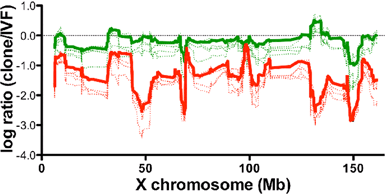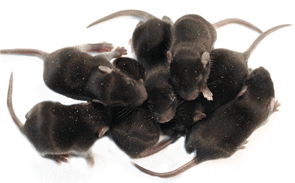 |
BRC Current Technology Jan 2012 |
3. Efficient mouse cloning by manipulating
|
|

The relative expression levels of X-linked genes plotted on the X chromosome position in Sertoli cell cloned embryos. The majority of down-regulated genes are increased in their expression levels in Xist-knockout clones (green), compared with (red) wild-type cloned embryos. |

A litter of cloned pups produced from Sertoli cell nuclei, following treatment with knockdown with Xist-siRNA. Seven pups were born from 23 embryos trans- ferred (30%) to a single recipient mother. |
| Fifteen years have passed since the report of the first somatically cloned mammals, Dolly the sheep. Somatic cell nuclear transfer (SCNT) is the sole reproductive engineering technique that can give rise to an animal from a single cell, and therefore, it is expected to contribute greatly to advancements of biological drug manufacturing, regenerative medicine, and agriculture. However, extremely low successful rates (< 5%) have hampered broad applications of this technique and, even in research field, only a few laboratories are actively undertaking mouse cloning study. Our division, the Bioresource Engineering Division at RIKEN BRC, is one of such laboratories and has made efforts to improve the cloning efficiency in mice. We found that Xist, a responsible for X chromosome inactivation in female cells, was the key for the improvement; in cloned embryos of both sexes, the Xist gene was ectopically expressed from the active X chromosome. When the expression of Xist in cloned embryos was normalized by the knockout or knockdown strategy, the birth rates of clones increased about tenfold (up to 20% per embryos transferred). The knockdown was performed by injection of siRNA against Xist into cloned embryos. Thus, although this strategy is applicable to only male clones at present, it is technically easy and does not cause any genetic alteration of cloned offspring. Freezing somatic cells may become one of the strategies for genetic preservation of mouse strains in future. | |
| RIKEN Research : http://www.rikenresearch.riken.jp/eng/research/6447 | |
| References: | |
| [1] Inoue et al., Science 330: 496-499 (2010) | |
| [2] Matoba et al., Proc Natl Acad Sci USA 108: 20621-20626 (2011) | |




